
Satellite images are images of Earth collected by imaging satellites operated by governments and businesses around the world. Satellite imaging companies sell images by licensing them to governments and businesses such as Apple Maps and Google Maps. It should not be confused for astronomy images collected by space telescope.
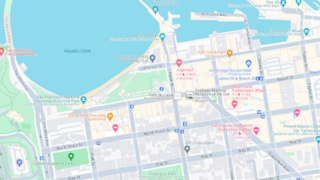
Google Maps is a web mapping platform and consumer application offered by Google. It offers satellite imagery, aerial photography, street maps, 360° interactive panoramic views of streets, real-time traffic conditions, and route planning for traveling by foot, car, air and public transportation. In 2020, Google Maps was being used by over 1 billion people every month around the world.

Google Earth is a computer program, formerly known as Keyhole EarthViewer, that renders a 3D representation of Earth based primarily on satellite imagery. The program maps the Earth by superimposing satellite images, aerial photography, and GIS data onto a 3D globe, allowing users to see cities and landscapes from various angles. Users can explore the globe by entering addresses and coordinates, or by using a keyboard or mouse. The program can also be downloaded on a smartphone or tablet, using a touch screen or stylus to navigate. Users may use the program to add their own data using Keyhole Markup Language and upload them through various sources, such as forums or blogs. Google Earth is able to show various kinds of images overlaid on the surface of the earth and is also a Web Map Service client. Recently Google has revealed that Google Earth now covers more than 98 percent of the world, and has captured 10 million miles of Street View imagery, a distance that could circle the globe more than 400 times.
Keyhole Markup Language (KML) is an XML notation for expressing geographic annotation and visualization within two-dimensional maps and three-dimensional Earth browsers. KML was developed for use with Google Earth, which was originally named Keyhole Earth Viewer. It was created by Keyhole, Inc, which was acquired by Google in 2004. KML became an international standard of the Open Geospatial Consortium in 2008. Google Earth was the first program able to view and graphically edit KML files, but other projects such as Marble have added KML support.

Panoramio was a geo-located tagging, photo sharing mashup active between 2005 and 2016. Photos uploaded to the site were accessible as a layer in Google Earth and Google Maps. The site's goal was to allow Google Earth users to learn more about a given area by viewing the photos that other users had taken at that location. Panoramio was acquired by Google in 2007. In 2009 the website was among 1000 most popular websites worldwide.

A partial solar eclipse occurred on October 2, 1978. A solar eclipse occurs when the Moon passes between Earth and the Sun, thereby totally or partly obscuring the image of the Sun for a viewer on Earth. A partial solar eclipse occurs in the polar regions of the Earth when the center of the Moon's shadow misses the Earth.

A partial solar eclipse occurred on December 4, 1964. A solar eclipse occurs when the Moon passes between Earth and the Sun, thereby totally or partly obscuring the image of the Sun for a viewer on Earth. A partial solar eclipse occurs in the polar regions of the Earth when the center of the Moon's shadow misses the Earth.
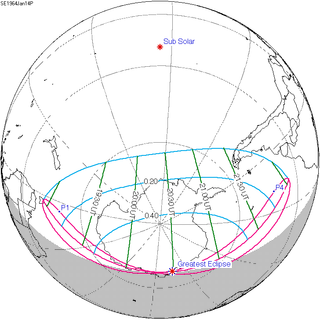
A partial solar eclipse occurred on January 14, 1964. A solar eclipse occurs when the Moon passes between Earth and the Sun, thereby totally or partly obscuring the image of the Sun for a viewer on Earth. Partial solar eclipses occur in the polar regions of the Earth when the center of the Moon's shadow misses the Earth.
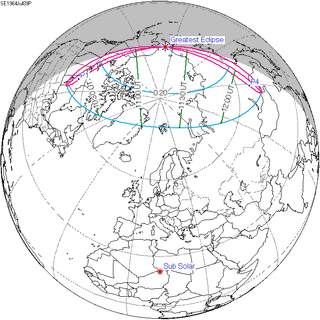
A partial solar eclipse occurred on July 9, 1964. A solar eclipse occurs when the Moon passes between Earth and the Sun, thereby totally or partly obscuring the image of the Sun for a viewer on Earth. A partial solar eclipse occurs in the polar regions of the Earth when the center of the Moon's shadow misses the Earth.
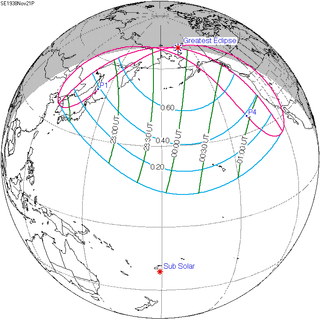
A partial solar eclipse occurred on November 21, 1938. A solar eclipse occurs when the Moon passes between Earth and the Sun, thereby totally or partly obscuring the image of the Sun for a viewer on Earth. A partial solar eclipse occurs in the polar regions of the Earth when the center of the Moon's shadow misses the Earth.

A partial solar eclipse occurred on November 10, 1920. A solar eclipse occurs when the Moon passes between Earth and the Sun, thereby totally or partly obscuring the image of the Sun for a viewer on Earth. A partial solar eclipse occurs in the polar regions of the Earth when the center of the Moon's shadow misses the Earth.
Google Building Maker was a web application that allowed users to build three-dimensional buildings for inclusion in Google Earth. Buildings were created using simple three-dimensional shapes combined with aerial photos. Google reviews new building submissions and includes them in Google Earth's three-dimensional buildings layer when they are of sufficient quality and a better model doesn't already exist. Building models could be exported for editing in SketchUp. There were at least 127 cities available.
Google Crisis Response is a team within Google.org that "seeks to make critical information more accessible around natural disasters and humanitarian crises". The team has responded in the past to the 2010 Haiti earthquake, 2010 Pakistan floods, 2010–11 Queensland floods, February 2011 Christchurch earthquake, and the 2011 Tōhoku earthquake and tsunami among other events, using Google resources and tools such as Google Maps, Google Earth, Google Person Finder, and Google Fusion Tables.
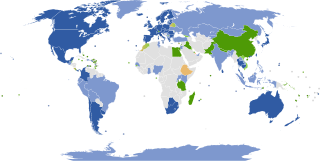
Google Street View was first introduced in the United States on May 25, 2007, and until November 26, 2008, featured camera icon markers, each representing at least one major city or area, and usually the other nearby cities, towns, suburbs, and parks. Many areas that had coverage were represented by icons.

Miss Earth 2013 was the 13th edition of the Miss Earth pageant. It was held on December 7, 2013 at the Versailles Palace in Alabang, Muntinlupa, Metro Manila, Philippines. Tereza Fajksová of the Czech Republic crowned her successor Alyz Henrich of Venezuela at the end of the event.

MyTracks was a GPS tracking application that runs on Android. The application uses a device's GPS to collect data, allowing real-time review of path, speed, distance, and elevation. Later, this data can be saved to Google Maps, Google Fusion Tables, or Google Docs and shared with Google+, Facebook, or Twitter. The application also allows a user to record annotations along the path, hear periodic voice announcements of progress, and sync with select third-party bio-metric sensors.
Google APIs are application programming interfaces (APIs) developed by Google which allow communication with Google Services and their integration to other services. Examples of these include Search, Gmail, Translate or Google Maps. Third-party apps can use these APIs to take advantage of or extend the functionality of the existing services.
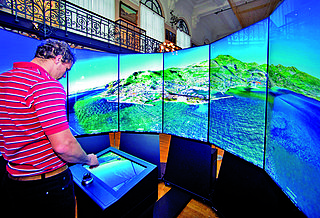
The Liquid Galaxy is an open source project founded by Google. Created in 2008 by Google employee Jason Holt, the Liquid Galaxy started out as a panoramic multi-display Google Earth viewer, but has evolved to become a general data visualization tool for operations, marketing, and research.













